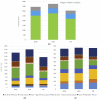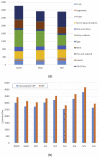Dietary recommendations in Spain -affordability and environmental sustainability?
- PMID: 33897918
- PMCID: PMC7610673
- DOI: 10.1016/j.jclepro.2020.120125
Dietary recommendations in Spain -affordability and environmental sustainability?
Abstract
Global food demand is increasing due to population growth and dietary transitions, resulting from rising incomes, are associated with increased prevalence of non-communicable diseases. Improving the sustainability of the food sector is also critical for achieving the Sustainable Development Goals. This study assesses for the first time the greenhouse gases emissions (Carbon Footprint - CF), the water footprint (WF) and the cost of three omnivorous diets recommended in Spain due to their health benefits: the Mediterranean diet (MD), the Southern European Atlantic diet (SEAD) and the Spanish dietary guidelines (NAOS). Analysis was conducted using standard Life Cycle Assessment and WF methods together with current Spanish food price data. The dietary energy recommendation of the SEAD is greater than that of MD and NAOS (11 and 15% respectively), and SEAD also has greater animal source food content than the other two diets. SEAD has a concomitantly higher CF, WF and cost scores in comparison with MD (+30%, +23% and +21% respectively) and NAOS (+15%, +9% and +21% respectively). Adjusting recommendations to meet the suggested Spanish adult dietary energy of 2228 kcal.capita-1.day-1 changed the environmental profiles of the diets and the NAOS has the highest environmental impact. However, the isocaloric diets had approximately the same cost. Analysis of the WF of the diets identified the major contribution of precipitation (the green WF) to the overall WF (88% of the total) and the significant contribution of animal-source foods to dietary WF. Regardless of the dietary scenario, better scores were identified for the Spanish recommendations analysed than those reported for other healthy diets identified in Europe. Differences in the recommended intake levels of certain food groups, cooking techniques and the origin of food products are behind these results. Environmental indicators should be considered alongside nutrition and health metrics when defining national dietary guidelines. Supporting citizens to follow healthy and environmentally-friendly dietary recommendations through, among other things, information campaigns and nutritional education programmes is essential. It is recommended the incorporation not only of health, but also of environmental indicators of these dietary options in the national dietary guidelines, as well as implementation of information campaigns and nutritional education programs among citizens to promote their adhesion since balanced dietary habits rich on plant-based products and low on animal-based ones involve multiple health and environmental benefits.
Keywords: Carbon footprint; Climate change; Diet; Food waste; Health index; LCA; Sustainable diet; Water footprint.
Conflict of interest statement
Declaration of competing interest The authors declare that they have no known competing financial interests or personal relationships that could have appeared to influence the work reported in this paper.
Figures




Similar articles
-
Balancing Nutritional and Environmental Sustainability Through the Evaluation of the Water Footprint of the Recommended Italian, Spanish, and American Diets.Nutrients. 2024 Dec 25;17(1):23. doi: 10.3390/nu17010023. Nutrients. 2024. PMID: 39796457 Free PMC article.
-
Driving commitment to sustainable food policies within the framework of American and European dietary guidelines.Sci Total Environ. 2022 Feb 10;807(Pt 2):150894. doi: 10.1016/j.scitotenv.2021.150894. Epub 2021 Oct 12. Sci Total Environ. 2022. PMID: 34653446
-
Differences in the cost and environmental impact between the current diet in Brazil and healthy and sustainable diets: a modeling study.Nutr J. 2024 Jul 9;23(1):71. doi: 10.1186/s12937-024-00973-x. Nutr J. 2024. PMID: 38982483 Free PMC article.
-
The Water Footprint of Diets: A Global Systematic Review and Meta-analysis.Adv Nutr. 2020 Mar 1;11(2):375-386. doi: 10.1093/advances/nmz091. Adv Nutr. 2020. PMID: 31756252 Free PMC article.
-
Carbon footprint and nutritional quality of different human dietary choices.Sci Total Environ. 2018 Dec 10;644:77-94. doi: 10.1016/j.scitotenv.2018.06.339. Epub 2018 Jul 4. Sci Total Environ. 2018. PMID: 29981520 Review.
Cited by
-
Assessment of the Methodology That Is Used to Determine the Nutritional Sustainability of the Mediterranean Diet-A Scoping Review.Front Nutr. 2021 Dec 23;8:772133. doi: 10.3389/fnut.2021.772133. eCollection 2021. Front Nutr. 2021. PMID: 35004806 Free PMC article.
-
Effects of a Community-Based Behavioral Intervention with a Traditional Atlantic Diet on Cardiometabolic Risk Markers: A Cluster Randomized Controlled Trial ("The GALIAT Study").Nutrients. 2021 Apr 7;13(4):1211. doi: 10.3390/nu13041211. Nutrients. 2021. PMID: 33916940 Free PMC article. Clinical Trial.
-
Epigenetic Effects of Healthy Foods and Lifestyle Habits from the Southern European Atlantic Diet Pattern: A Narrative Review.Adv Nutr. 2022 Oct 2;13(5):1725-1747. doi: 10.1093/advances/nmac038. Adv Nutr. 2022. PMID: 35421213 Free PMC article. Review.
-
Sustainability Dimensions of the Mediterranean Diet: A Systematic Review of the Indicators Used and Its Results.Adv Nutr. 2022 Oct 2;13(5):2015-2038. doi: 10.1093/advances/nmac066. Adv Nutr. 2022. PMID: 35679078 Free PMC article.
-
Diets can be consistent with planetary limits and health targets at the individual level.Nat Food. 2025 May;6(5):466-477. doi: 10.1038/s43016-025-01133-y. Epub 2025 Mar 21. Nat Food. 2025. PMID: 40119219
References
-
- ADF. Atlantic diet foundation. 2019 https://www.fundaciondietatlantica.com/eng/index.php.
-
- AECOSAN. Agencia Española de Consumo, Seguridad Alimentaria y Nutritión. Ministerio de Sanidad. Servicios Sociales e Igualdad; Madrid: 2015. Evaluatión y seguimiento de la estrategia NAOS: conjunto mínimo de indicadores. 2015. (In Spanish). http://www.aecosan.msssi.gob.es/AECOSAN/web/nutricion/subseccion/indicad....
-
- Agnoli C, Sieri S, Ricceri F, Giraudo MT, Masala G, Assedi M, Panico S, Mattiello A, Tumino R, Giurdanella MC, Krogh V. Adherence to a Mediterranean diet and long-term changes in weight and waist circumference in the EPIC-Italy cohort. Nutr Diabetes. 2018;8:22. doi: 10.1038/s41387-018-0023-3. - DOI - PMC - PubMed
-
- Batlle-Bayer L, Bala A, García-Herrero I, Lemaire E, Song J, Aldaco R, Fullana-i-Palmer P. The Spanish Dietary Guidelines: a potential tool to reduce greenhouse gas emissions of current dietary patterns. J Clean Prod. 2019;213:588–598.
Grants and funding
LinkOut - more resources
Full Text Sources
Research Materials
